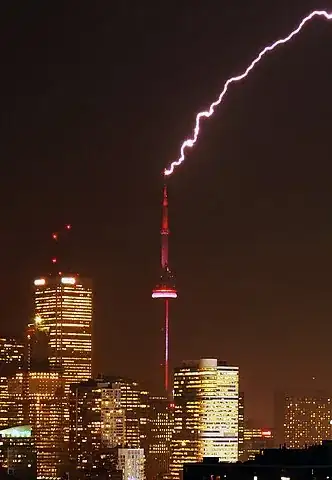Note that I’m talking about the visual aspect of a lightning bolt: normal lightning bolts, according to a simple Google search, are only about an inch (3 cm) in diameter, but they appear much bigger from a distance thanks to the light they emit. Basically, I’m asking how big a lightning bolt appears to be to the naked eye, not how big a bolt actually is.
4 Answers
Well, if all what you care is just the visual (subjective) perception of how wide a lightning bolt looks like, here we go. We take as an example lightning which very often hits CN Tower in Toronto:
According to the public data tower base is about $66.6~m$ wide.
Now we grab tower schematics -
and measuring its base in some image editing tool like GIMP,- gives us that tower "inverse DPI" resolution at base is $\approx 85 \text{cm/pixel} \tag 1$.
Now measure in the same image editing program the width of the tower place in pixels where lightning hits,- i.e., the width of the upper part of the antenna, multiply it with $DPI^{-1}$ in (1) and we get that the upper part where the lightning hits is about $2.5~m$ wide. Hence we conclude that visually the lightning bolt, which hit CN Tower and was taken in the given picture, must be at least $2.5m$ wide or greater (lower bound).
- 2,348
- 16,916
There are a couple ways the answer could go.
The 1 inch diameter probably refers to plasma generated by the bolt. The air for some distance around it might be hot enough to glow.
Then there are visual effects. You can't see anything smaller than a receptor in your eye. This means anything smaller than about an arc minute appears to be an arc minute. You can see this in starlight. The actual angle of the disk is too small to resolve with a good telescope. You just see the minimum size your eye can resolve.
Your eyesight might not be perfect. A blurry image appear bigger. You might move your eyes during the stroke. This would make the bolt cover more receptors.
Photographs of lightning would be subject to the same considerations.
- 49,702
When I was a teenager I had a newspaper delivery round; one morning a storm broke as I was out delivering papers and a lightning bolt struck the ground just in front of me. It seemed to me to be about a 1 to 1.5 metres in diameter. The blast (there's not really any other word for it) was enough to throw me backwards off my bicycle. About 30 seconds later another bolt struck the ground across the road; it also seemed to be just as wide as the first.
- 281
- 4
There are several contributing effects:
- The actual initial width of the plasma itself. This is surprisingly small - this paper indicates that peak optical output occurs at only ~3mm radius for the modeled 20kA stroke.
- The plasma expansion with time. As the return stroke starts, you get a column of very hot plasma in the air. This is obviously unstable, and rapidly radially expands. The plasma also rapidly cools... but doesn't do so instantly. Said paper indicates that even 50us into the return stroke there is still a fair amount of optical output, and the plasma has expanded significantly (to ~7mm radius). Unfortunately, figure 6d) stops at 50us.
- Diffraction limit. The human eye is ~3x worse than the theoretical maximum here, at somewhere around 60 arcseconds. This in turn works out to somewhere around 30cm at 1km.
- Dazzle and other effects. Lightning is bright [Citation Needed]. Our eyes are not perfect, and internal optical reflections happen. This is somewhat comparing apples to oranges here, but some empirical equations from laser dazzle are as follows. (These equations assume monochromatic light; lightning's optical spectrum isn't. Ditto, lightning is not a coherent source, and is a line rather than a point. Ditto, these equations are more designed for steady-state, whereas lightning isn't.) Said 20kA stroke has a peak optical power on the order of 4.3MW/m. Take a slice of this 3m long (diffraction-limited at 10km), and that's a peak optical output of ~10mW/m^2. Peak optical output seems to be in the blue region of the spectrum, so $V = 0.0647$ from their paper. Multiplying through, that's a MDE of ~660uW/cm^2. From the paper's table, this indicates this would be between 1-5 degrees radius of dazzle in full daylight, or >20 degrees of dazzle at dusk/dawn (the paper indicates 20 degrees of dazzle at ~450uW/cm^2). Note that even 1 degree radius of dazzle at 10km is an effective visible width of ~350 meters.
Again, note bunches of caveats.
- 213

